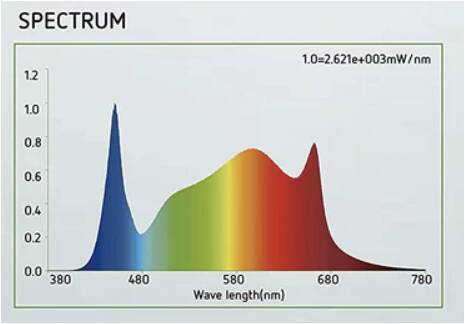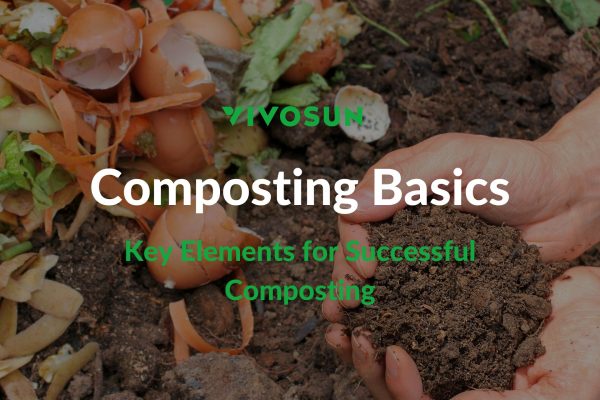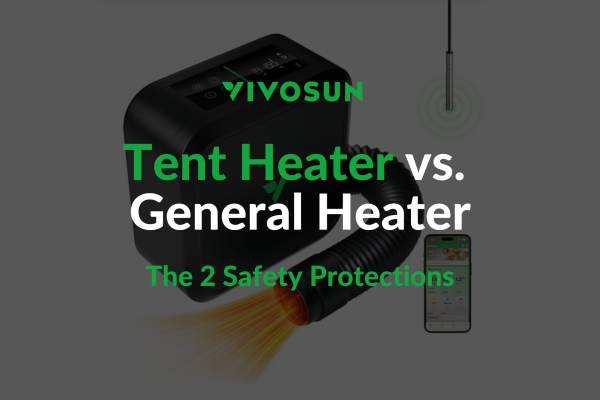
Different color spectrums have different effects on the plants—your yields are heavily dependent on the light color you have chosen during different planting stages. It’s hard to say exactly which color light works best for your plants. You’ve probably heard that red light emphasizes flowering and blue light emphasizes growing, but we’re going to break it down in more detail so you’ll have a better sense of how light affects your plant.
How does the color spectrum affect plants?
Usually, the color spectrum refers to the light you can “see.” For example, when light passes through a glass prism it will be divided into 7 colors: red, orange, yellow, green, blue, indigo, and purple—the same as a rainbow, which is light dispersed by rain. Visible light is part of electromagnetic radiation—this radiation (think “radiate”) is the product of particles interacting with magnetic fields, so when an electron passes through the magnetic field it combines with other particles to create packets of particles called photons.
We’re quickly getting into particle physics here, so we’ll be brief: photons are packets of particles that act like a single particle. We experience electromagnetic radiation in many ways: as X-rays, radio waves, visible light, etc. Our bodies are in tune with this radiation in different ways, but today we’ll focus on the visible spectrum, what our eyes can see because this is also what plants use.
The visible spectrum is the portion of the electromagnetic spectrum that has wavelengths (measured from trough to peak) from about 380 nanometers to about 740 nm. Among these light colors, blue light and red light contribute most to the growth of your plants.
Blue light
The wavelength of blue light ranges from about 400-500nm and is right above ultraviolet radiation. This portion of the wavelength can stimulate the production of secondary pigments in the leaves, helping the leaves of your plants to grow healthy and strong, meaning your plant has more surface area to both capture energy and transpirate. Blue light can also help your plants to grow healthy roots and stems. Blue spectrum light is the primary driver during the vegetative stage of growth because of how it encourages a plant to grow taller and larger, more numerous leaves.
If you don’t provide enough blue light during the vegetative stage your plants will grow slowly, they will likely be weaker and will be yellow or pale rather than their natural green coloration. However, once you enter the flowering stage too much blue light will stunt your plant’s flower production. If you continue to use primarily blue light beyond the vegetation stage, you’ll start to see a phenomenon called “stretching,” when a plant’s stems and branches overextend and the plant begins to look sparse.
Lamps like fluorescent lights, Metal Halide or Ceramic Metal Halide, or LED grow lights all excel at producing blue light. That said, fluorescent, MH, and CMH bulbs don’t produce enough red light to transition your plant into the flowering stage.

Red light
Red light sits somewhere between 620-750nm in wavelength. Among all the colors in the spectrum, red light produces the most heat because it is close to the infrared portion of the spectrum, so that is something to be aware of. That said, infrared light is also key to producing uniform fruiting bodies but too much-infrared light will damage plants, causing discoloration or killing them entirely.
Red light (620-700nm) encourages the development of fruiting bodies because it stimulates the production of Chlorophyll A, which in turn is used in the process of photosynthesis to create the organic compounds plants use to build flowers, fruit, buds, and other structures that you’re trying to grow. That all said, you don’t want to use just red light for your entire growth since this is known to cause elongation—when you’re flowering, you’ll want a ratio of 80-90% red and 10-20% blue light.

Greenlight
Compared with blue light and red light, green light is not that important. Plants look green, which means plants absorb the least green light and reflect most of the green light back to us. Seldom leaves appear blue or red because they absorb them. Therefore, it is usually believed that green light has nothing to do with photosynthesis. However, some study shows although plants don’t need as much green light as they need blue and red light, they still do need some.
From our experience, plants react and grow differently under green light since it is able to penetrate deeply into the canopy and be absorbed by leaves that don’t receive as much blue or red light. So if you are open to experimenting with your plants, you can try using green light during the “night” phase of the photoperiod. Cannabis is very sensitive to light and even a tiny amount of light can encourage them to flower, even prematurely. Adding a bit of green light during the day period can help maximize photosynthesis and using green light at night can help you check on your plants without disturbing them.

So what is the best color spectrum for vegetative growth?
Simply, blue light is the most important color on the spectrum for vegetative growth. It helps create Chlorophyll B that the plants need for photosynthesis and then use to build organic compounds that are used for structural growth and resilience, thus improving the health, size, and later yield of your plants.
On one hand, with the accumulation of chlorophyll, the leaves become denser and the stem grows stronger. If you don’t encourage strong growth during the vegetative stage, your plants will not be able to support flowering physically or nutritionally.
Further, blue light does well to adjust the opening and closing of stomata, which allows gas exchange and CO2 intake. Blue light is also proven to improve the content of terpenes, which means a lot to growers since it improves the quality of your harvest. Terpenes are pungent oils found in cannabis that give it distinctive aromas like citrus fruits, berries, mint, and pine.
This article is only a reference to help you to grow indoors—of course, different plants prefer different color spectrums and different photoperiods! Even if you have the seeds from the same mother plant your yields can vary dramatically based on your greenhouse location, the season, and so many other factors it is hard to list them all in one place.
Remember, growing cannabis is a science, so think like a scientist: you need to keep observing and calculating which color spectrum you’re using, the results you’re getting, and how much light you need to add in order to make up for the lack of natural light, your nutrient balance, and all of the other little details that go into growing. Be observant, be reflective, and record your data. Once you pick the right color spectrum for your plants, you will benefit a lot, not only with high-quality harvests but also with larger amounts!
If you have any questions, please don’t hesitate to reach out to us!
And be sure to check out our other blog posts for useful tips on becoming a great grower!
Subscribe to the VIVOSUN newsletter for growing tips, grower stories, and special offers, and get 12% off your first order!
We love the new VIVOSUN Smart Grow System and we are certain that you too will love it once you try it.
And join our Facebook farmer’s community for even more exclusive contests and prizes!
Download VIVOSUN App to get 18% off and explore more information!







